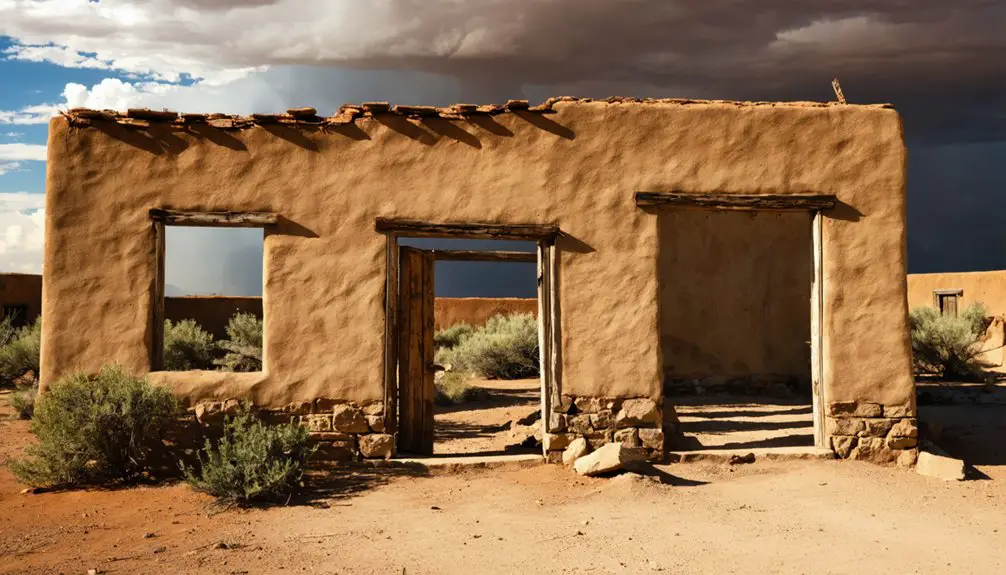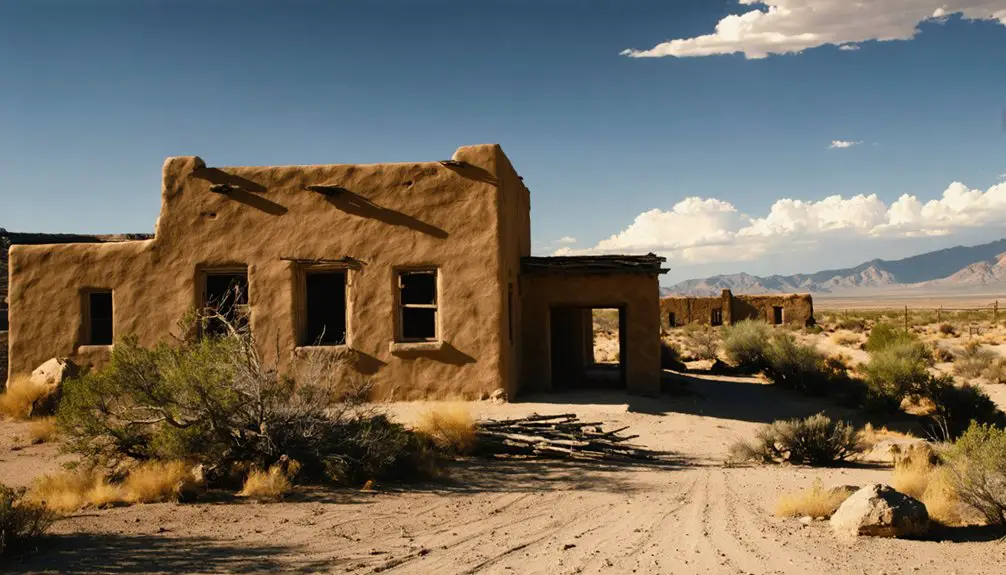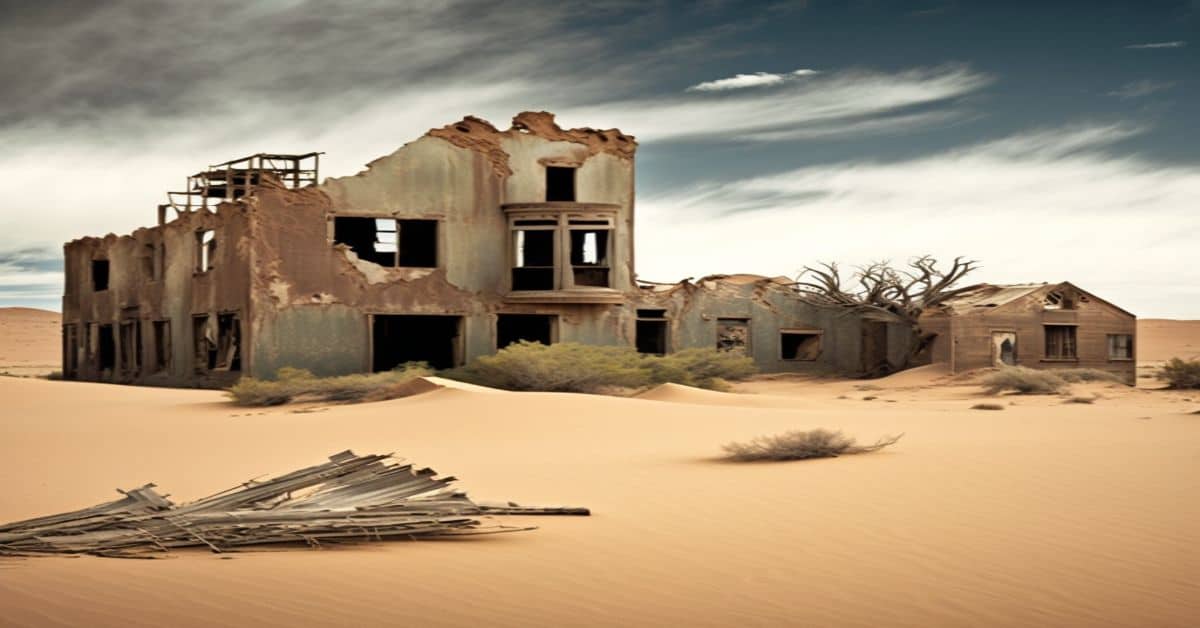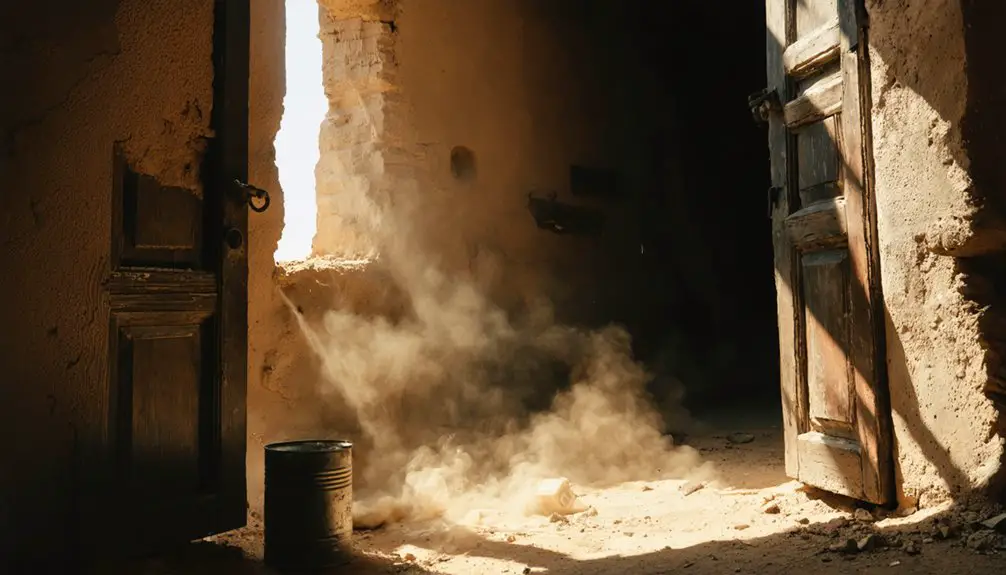You’ll find Cabezon’s adobe ruins beneath the dramatic basalt cliffs of Cabezon Peak, where this once-thriving Hispanic settlement flourished from 1826 to the 1930s. The town served as an essential stagecoach stop between Santa Fe and Prescott, growing into a commercial hub under Richard Heller’s leadership with 10,000 sheep and a bustling wool trade. Today, the weathered remains of its trading post and church hold tales of prosperity, murder, and mysterious desert legends.
Key Takeaways
- Cabezon was established in 1826 as a thriving agricultural settlement and stagecoach stop between Santa Fe and Prescott, Arizona.
- The town peaked in 1920 with 250 residents and a prosperous economy built around sheep ranching and wool trading.
- Richard Heller’s trading post served as the town’s commercial center, managing 10,000 sheep and extensive wool trade networks.
- Natural disasters in the 1930s, including the breaking of the Río Puerco dam, led to the town’s abandonment.
- The ghost town’s remaining adobe structures include the historic La Iglesia de San Jose church and trading post ruins.
The Birth and Early Days of Cabezon
On the dusty trails of New Mexico’s frontier, Cabezon emerged as an important settlement in 1826 when Juan Maestas journeyed south from Pagosa Springs, Colorado, to establish his new home.
Originally known as La Posta, the settlement’s Cabezon origins were rooted in its strategic location as a stagecoach stop between Santa Fe and Prescott, Arizona.
You’ll find it was one of four notable Hispano agricultural settlements in the region, alongside Guadalupe, San Luis, and Casa Salazar.
The early settlers transformed this remote outpost into a significant hub when they established an official post office in 1879, marking the town’s formal recognition as Cabezón Station.
This dual-purpose community served both as an agricultural center and an essential transportation link, connecting regional trade networks with farming communities.
The site’s location at the crossroads of trails between Zuni Pueblo, Jemez Pueblo, and a Spanish trail from Albuquerque to Cuba made it a natural gathering point for diverse cultures.
The community thrived until the natural disasters of the 1930s forced residents to abandon their homes and livelihoods.
A Trading Post Turned Thriving Community
At the heart of Cabezon’s transformation into a bustling frontier settlement stood the trading post, first established in 1874 by William Kanzenbach as a combined store and saloon.
Kanzenbach’s 1874 trading post marked the beginning of Cabezon’s evolution from wilderness outpost to thriving commercial center.
You’ll find the historical significance of this site reflected in its role as a crucial hub of cultural exchange between Navajo traders and outside merchants. Like many early establishments, the post began as a tent and plank structure before permanent buildings were constructed. Similar to the one-room schoolhouse teaching style of early New Mexico, the trading post served as an educational center where cultures met and learned from each other.
- Richard Heller acquired full ownership in 1894, expanding operations to include 2,000 head of cattle.
- Trading volumes reached up to 40 wagon loads to Albuquerque markets in peak years.
- Local materials shaped the architecture, including rock walls and wooden vigas from Mt. Taylor.
- The post served as both marketplace and social center, offering credit-based transactions.
- Peak trading occurred during lambing season and fall cattle sales, establishing economic stability for Navajo families.
Life in the Shadow of Cabezon Peak
Life beneath the towering Cabezon Peak took shape in 1826 when settlers first established what would become a vibrant farming community.
You’d find yourself immersed in community rituals centered around La Iglesia de San Jose, where locals gathered for spiritual and cultural connections. The harsh climate and environmental challenges shaped your daily existence, as you’d battle hot, dusty summers while tending to vast herds of sheep and cattle.
You’d witness both prosperity and hardship in this isolated settlement, where up to 10,000 sheep grazed the surrounding lands. The trading post and blacksmith shop served as your lifeline to essential supplies, while adobe homes with traditional vigas offered shelter from the elements.
Yet the breaking of the Río Puerco dam would ultimately signal the beginning of the end for this once-thriving community.
The Heller Legacy and Economic Prosperity
Richard Heller’s arrival in Cabezon in 1888 marked the beginning of an era of unprecedented economic growth, as he transformed a struggling trading post into a thriving commercial empire.
This bustling community was sustained by adobe buildings constructed from local materials, with stones gathered from nearby hills and timber sourced from Mount Taylor.
You’ll find that Heller’s business acumen led to the expansion of operations beyond simple trading, encompassing a massive livestock enterprise of 10,000 sheep and 2,000 cattle, along with sophisticated wool brokerage operations that transported up to 40 wagon loads annually to Albuquerque.
The trading post’s success under Heller’s leadership brought prosperity to Cabezon, attracting a peak population of 250 residents by 1920 and establishing the town as an essential economic hub that served both Native American and settler communities.
Heller and his partner John Pflueger demonstrated remarkable business skills by paying off Ilfeld within just six months of acquiring the trading post.
Trading Post Operations
The economic prosperity of Cabezon reached its zenith under the astute management of the trading post by Richard Heller, who arrived in 1888 to partner with John Pflueger.
Similar to the later Rice trading post in Budville, the trading dynamics revolved around a complex barter system that served both local and Navajo communities, with the post acting as a crucial economic hub. Like many trading posts that emerged in Navajo country, this establishment became a vital center of commerce after 1851.
You’ll find these essential elements that defined the trading post’s operations:
- Extensive inventory including Arbuckles coffee, flour, sugar, and canned goods
- Household necessities from calico cloth to cookware hung from ceiling to floor
- Livestock management facilities with corrals and hay barns
- Brokerage services for wool, with up to 40 wagon loads transported to Albuquerque annually
- Guest hogans and accommodations for travelers along the Santa Fe to Prescott route
Ranching Empire Growth
Following his arrival in 1888, Cabezón’s ranching empire flourished under Richard Heller’s strategic vision, growing from a modest trading post partnership with John Pflueger into a formidable agricultural enterprise.
After buying out Pflueger in 1894, Heller expanded operations to include 10,000 sheep and 2,000 cattle, establishing himself as a dominant force in regional agriculture. The region first saw initial settlement in the 1760s. Similar to federal government policies in other New Mexico regions, changing regulations in the 1920s dramatically impacted local ranching operations.
From his 11-room adobe headquarters, Heller managed this thriving enterprise for nearly 60 years until drought, government land restrictions, and broken irrigation systems in the 1940s gradually eroded the ranch’s viability.
You’ll find that Heller’s success stemmed from his innovative approach to ranching challenges, particularly in wool brokerage with Navajo producers. His operation transported up to 40 wagon loads of wool annually to Albuquerque markets.
Community Economic Impact
Under Heller’s strategic leadership, Cabezón transformed from a modest trading outpost into a thriving economic hub that shaped regional commerce throughout the late 1800s and early 1900s.
You’ll find that his innovative approach to economic sustainability centered on diversifying local industries and fostering community resilience through strategic partnerships.
- Built a massive wool trade network, moving 40 wagon loads annually to Albuquerque
- Established a vertically integrated economy with 10,000 sheep and 2,000 cattle
- Constructed an impressive general store in 1910-1911 as the town’s commercial anchor
- Created sustainable employment through year-round production and trade
- Developed essential economic ties with Navajo wool producers
This economic foundation brought unprecedented prosperity to Cabezón, as Heller’s business acumen created a self-sustaining ecosystem of trade, employment, and regional cooperation that defined the town’s golden era.
Tales and Mysteries From the Desert
Like many ghost towns scattered across the American Southwest, Cabezon harbors dark tales that continue to intrigue visitors and historians alike.
You’ll find the town’s most notorious unsolved crime centers on the gruesome ax murder from the early 1900s, when Juan Valdez was found beheaded after accusing post office clerk Emiliano Sandoval of theft.
While Sandoval and his accomplices were arrested, they were later released due to lack of evidence. This violent episode has spawned ghostly legends that persist in the town’s crumbling adobe ruins.
As you explore the remaining 15 structures, including the historic church and trading post, you might sense the weight of untold stories.
The isolation and harsh desert setting only amplify the mysterious atmosphere that surrounds this abandoned settlement.
Preserving an Adobe Time Capsule

If you’ve ever wondered how Cabezon’s adobe buildings withstood harsh desert conditions, you’ll find their thick clay walls were carefully constructed with rock foundations and wooden vigas from Mt. Taylor.
You’ll notice these structures required annual maintenance, including protective mud plaster coatings mixed with lime to prevent erosion and structural damage.
While many original adobes have deteriorated from weather and vandalism, community efforts now focus on preserving these cultural treasures through controlled access and specialized conservation techniques.
Adobe Construction Methods
While preserving Cabezon’s adobe structures requires meticulous attention to traditional building methods, understanding the core composition and construction techniques proves essential for maintaining these historical treasures.
Traditional adobe materials reflect the region’s natural resources, combining local soil, water, and organic materials like straw for peak strength.
- Hand-molded bricks must dry for several weeks, with regular turning to prevent warping
- Soil mixture requires balanced proportions of sand, silt, and clay for durability
- Craftsmen carefully monitor moisture content during mixing, molding, and curing phases
- Wooden molds guarantee consistent brick sizes for proper load distribution
- Minimal mechanical alterations preserve historical authenticity
You’ll find these time-tested techniques create sturdy structures that have withstood centuries of New Mexico’s harsh climate.
Protection Against Weather Damage
Though Cabezon’s adobe structures have endured decades of harsh New Mexico weather, they require constant vigilance against environmental threats. The buildings’ weather vulnerability stems from multiple challenges: rain and flash floods can erode walls, freeze-thaw cycles cause cracking, and intense sun exposure leads to surface deterioration.
You’ll find several preservation techniques that help protect these historic structures. Installing overhanging roofs shields walls from direct rainfall, while protective lime plaster coatings increase water resistance. Windbreaks reduce erosion, and proper drainage prevents water from pooling at foundations.
Regular inspections and prompt repairs are essential, especially after storms. While Cabezon’s remote location and limited resources create preservation challenges, these protective measures help safeguard the town’s remaining adobe heritage against New Mexico’s unforgiving climate.
Community Preservation Efforts
Local community efforts have been instrumental in shaping Cabezon’s preservation story since the 1970s. Through dedicated volunteer initiatives and community engagement, you’ll find a remarkable example of grassroots preservation in action.
- La Iglesia de San Jose’s restoration showcases the community’s commitment, culminating in a 500-person centennial celebration.
- Local volunteers contribute unpaid labor and donated materials to preserve adobe structures.
- The church bell’s protection and reinstatement demonstrates proactive security measures.
- Descendants of original landowners maintain stewardship, ensuring historical continuity.
- Coordination with land management agencies helps regulate access and protect resources.
You’re witnessing a living reflection of community-driven preservation, where residents actively safeguard their heritage through controlled access measures and strategic restoration projects, despite limited funding and challenging conditions.
Frequently Asked Questions
How Far Is Cabezon From Modern-Day Albuquerque?
You’ll find Cabezon about 58 miles from Albuquerque’s attractions, taking I-25 North and US 550 West. The historic ghost town offers a fascinating glimpse into New Mexico’s untamed past.
Are Paranormal Investigations Allowed at the Ghost Town Site?
Cold as a ghost’s whisper, you’ll find paranormal activities aren’t officially permitted. Due to private property restrictions and strict investigation guidelines, you’d need explicit permission from the sole resident owner.
What Native American Tribes Originally Inhabited the Cabezon Area?
You’ll find the Navajo (Diné) and Tsenajin were the primary tribes with deep tribal history in this area, where they attached great cultural significance to Cabezon Peak in their creation stories.
How Many Original Buildings From the 1800S Remain Standing Today?
You’ll discover about 15 original buildings still standing from the 1800s, including the historically significant Iglesia de San Jose church, showcasing remarkable adobe and stone architecture despite time’s relentless passage.
Can Visitors Attend the Annual Church Services at Iglesia De San José?
You can attend annual church services at Iglesia De San José, but you’ll need to coordinate with local caretakers first. The historical significance makes these services popular, so plan ahead for access permission.
References
- https://cityofdust.blogspot.com/2023/09/beneath-giants-head-cabezon-new-mexico.html
- https://www.nmtim.com/photo-stories/cabezon-country
- https://jwshaffner.jalbum.net/Cabezon
- https://www.newmexicomagazine.org/blog/post/ghosts-of-the-rio-puerco/
- https://www.ghosttowns.com/states/nm/cabezon.html
- https://familyrvingmag.com/2005/04/01/ghost-towns-of-new-mexico/
- https://discover.hubpages.com/travel/Discover-the-Haunting-Beauty-of-Americas-Ghost-Towns
- https://visitfourcorners.com/navajo-trading-posts-in-the-four-corners/
- https://cityofdust.blogspot.com/2017/10/nasario-remembers-rio-puerco.html
- https://elchuqueno.com/city-of-dust-cabezon-new-mexico/



